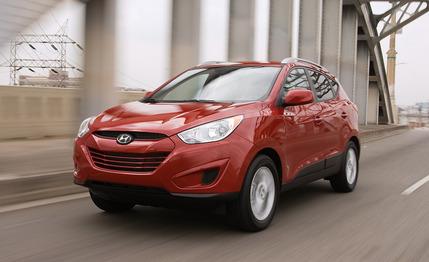 First Drive Review
First Drive Review
Hyundai has long patterned its strategy after Toyota’s, and like the Japanese giant, the Korean company has crammed its own product lineup and that of its subsidiary, Kia, with vehicles to meet every conceivable need. Redesigned for 2010, the new five-seat Hyundai Tucson crossover wedges itself into the scant space separating the slightly larger Hyundai Santa Fe with the slightly cheaper Kia Sportage.
Still, the 2010 Tucson proves that Hyundai is keen to eventually move out of Toyota’s long shadow. The clean, swept styling with its daggers and scimitars up front is much friskier than anything Toyota has tried in this segment. And Hyundai is taking a small-engine approach that Toyota has eschewed by offering a large, powerful V-6 in its RAV4.
Configured for Competitiveness
About three inches longer and one inch wider than the previous version, this Tucson takes aim at a crossover segment already populated with fine choices, including the Nissan Rogue, the Honda CR-V, the Mitsubishi Outlander, and—to a lesser extent because it’s larger and available in more trim levels—the Toyota RAV4. Hyundai’s differentiator: low prices and adventurous styling.
Hyundai has kept it simple with two available trim levels, GLS and Limited. With a sunroof and a stereo/navigation upgrade being the main options, there are only 100 buildable combinations irrespective of color choice, says Hyundai. Build-sheet simplification has proven successful for Toyota and Honda, so it's no surprise that Hyundai is going down this road.
The base price is $19,790 for a front-wheel-drive GLS with the six-speed manual; it’s a grand more for the six-speed automatic. Auto-only Limited models start at $25,140. All 2010 Tucsons are available only with a 2.4-liter four making 176 hp and 168 lb-ft of torque (or 170 hp and 163 lb-ft in models carrying the PZEV emissions classification). Electronic all-wheel drive is available on both trim levels and costs $1500 on Limited models. All-wheel-drive GLS Tucsons, however, command at least $23,990 because you must also get the $1700 Popular Equipment package—17-inch aluminum wheels, a telescoping steering wheel with audio controls, a leather-wrapped steering wheel and shift knob, Bluetooth, cruise control, and other conveniences—or the $3700 Navigation package, which adds to the Popular Equipment package auto headlights, nav, a 6.5-inch display, a rearview camera, and a premium audio system. Fuel economy composites all land in the mid-20s.
Pleasing Innards
If you like the look of the new Tucson on the outside, the interior is even better. Hyundai is becoming the one to watch on interior quality at this price level. The 2010 Tucson ups the jewelry content with silver accents on the steering wheel and center console, as well as expensive-feeling buttons on the nice dash. The interior panel fits are good, and the twin gauge tubes are sporty-looking and functional.
The rear bench sits high off the floor and offers enough legroom and knee clearance to allow a six-footer to sit behind himself. One-step folding seats open up the rear cargo area from 26 cubic feet to 56, keeping the Tucson on the smaller end of the class compared with the Rogue (29/58), CR-V (36/73), and RAV4 (36/73).
Still Room to Improve
Smooth and quiet, the two-wheel-drive Tucson glides over corrupted pavement with a relatively gentle footfall. Not so with the all-wheel-drive version. It has a stiffer suspension that clops down harder on the rough stuff. Based on the Elantra compact car, the Tucson has struts up front and a multilink rear suspension. The electric power steering supplies a super-tight turning circle—34.7 feet—but doesn’t move Hyundai’s reputation much for lack of road feel. Engineers tried to make it sportier by stair-stepping the power assist with speed, a common practice, but they went overboard on the Tucson. At 60 mph, its steering suddenly becomes monstrously heavy, and the wheel snaps back to center as though it were spring-loaded. It reeks of robotic artificiality. Get thee back to the test track, Hyundai!
On sale this month, the Tucson makes strides in some areas and needs minor fixes in others to be a truly standout product in a hotly contested class.